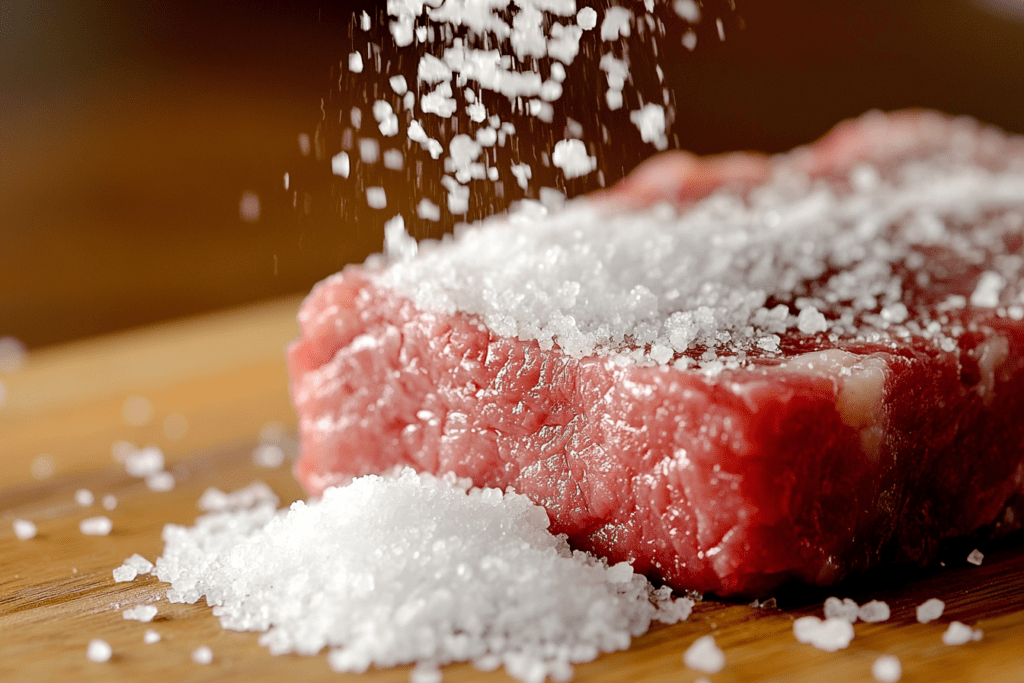A perfectly cooked steak shouldn’t require a premium price tag. Whether you’re working with a chuck eye, sirloin, or flat iron cut, these nine proven methods will help you achieve steakhouse results without breaking the bank.
Start with a proper dry brine

The foundation of a great steak begins with salt. Salting your steak and letting it rest for several hours or overnight doesn’t just enhance flavor – it fundamentally changes the meat’s protein structure, resulting in better moisture retention and tenderness.
For best results, use one teaspoon of kosher salt per pound of meat. Place the salted steak on a wire rack over a baking sheet and refrigerate uncovered. This allows the surface to dry slightly, promoting better browning when you cook.
Break down tough fibers with mechanical tenderizing
A meat mallet isn’t just for chicken – it’s a powerful tool for improving cheaper steaks. Focus on even pressure rather than aggressive pounding. Work systematically across the surface, creating a uniform thickness that will cook more evenly.
No mallet? The tines of a fork can work in a pinch. Pierce the surface in a regular pattern, but avoid overdoing it – you want to tenderize, not shred.
Use enzymes to your advantage

Pineapple juice contains bromelain, an enzyme that naturally breaks down protein fibers. A 30-minute soak can significantly improve texture. For milder tenderizing, plain yogurt or buttermilk work through similar enzymatic action.
Remember to pat the meat completely dry before cooking, regardless of which tenderizing method you choose. Excess moisture will interfere with proper browning.
Master the art of butter basting
Transform your pan-seared steak by adding butter, garlic, and hardy herbs like thyme or rosemary during the final minutes of cooking. Tilt the pan slightly and continuously spoon the aromatic butter over the meat.
This technique adds richness and helps develop a more even crust. The milk solids in butter also contribute to better browning through the Maillard reaction.
Consider sous vide for perfect doneness

Precise temperature control can make all the difference with budget cuts. A 24-hour sous vide bath at 130°F breaks down tough connective tissue while maintaining a perfect medium-rare. Finish with a quick sear in a blazing-hot cast iron skillet.
If you don’t have a sous vide device, try the reverse sear method: slow-cook in a low oven until nearly done, then sear to finish.
Pay attention to grain direction
The way you slice your steak matters as much as how you cook it. Look for the direction of the muscle fibers and cut perpendicular to them. This shortens the fibers, making each bite more tender.
For cuts like flank or skirt steak, slice at a 45-degree angle against the grain for maximum tenderness.
Create a proper resting environment
After cooking, transfer your steak to a wire rack over a plate. This prevents the bottom from steaming and maintains the crust you worked so hard to develop. Five minutes per inch of thickness is the minimum rest time.
Tent loosely with foil if needed, but avoid wrapping tightly – trapped steam will make your crust soggy.
Choose the right pan
Cast iron is ideal for developing a serious crust on budget steaks. Its heat retention and natural non-stick properties after proper seasoning make it perfect for high-heat searing.
Preheat your pan for at least 10 minutes over medium-high heat. It should be hot enough that a drop of water instantly vaporizes.
Make a pan sauce
Those browned bits stuck to your pan after cooking? They’re pure gold. Deglaze with red wine or beef stock, add a knob of butter and some fresh herbs, and you’ve got a restaurant-worthy sauce that will elevate any cut.
With these techniques in your arsenal, you’ll find that even the most modest cuts can deliver extraordinary results. The key is understanding how each method contributes to improving tenderness, developing flavor, and ensuring proper cooking. Perfection isn’t about the price tag – it’s about technique and attention to detail.


